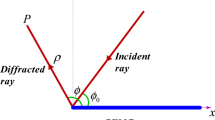Summary
The exact solution is obtained for the problem of a plane wave incident at an oblique angle on a half-plane of large but finite conductivity. The usual approximate boundary conditions are applied and lead to coupled Wiener-Hopf integral equations from which to determine the currents excited on the surface of the sheet. The resulting expressions for the field components are found to be entirely different from those which would have been obtained by applying the technique used for the derivation of three-dimensional solutions in the case of perfectly conducting structures, and, indeed, not one component is given to the required accuracy by this technique.
Similar content being viewed by others
References
Clemmow, P. C., Proc. Roy. Soc.205 (1951) 286.
Senior, T. B. A., Quart. J. Mech. Appl. Math.6 (1953) 101.
Senior, T. B. A., Proc. Roy. Soc.213 (1952) 436.
Stratton, J. A., Electromagnetic Theory, McGraw-Hill, New York, 1941.
Author information
Authors and Affiliations
Rights and permissions
About this article
Cite this article
Senior, T.B.A. Diffraction by an imperfectly conducting half-plane at oblique incidence. Appl. sci. Res. 8, 35–61 (1960). https://doi.org/10.1007/BF02920043
Received:
Issue Date:
DOI: https://doi.org/10.1007/BF02920043




